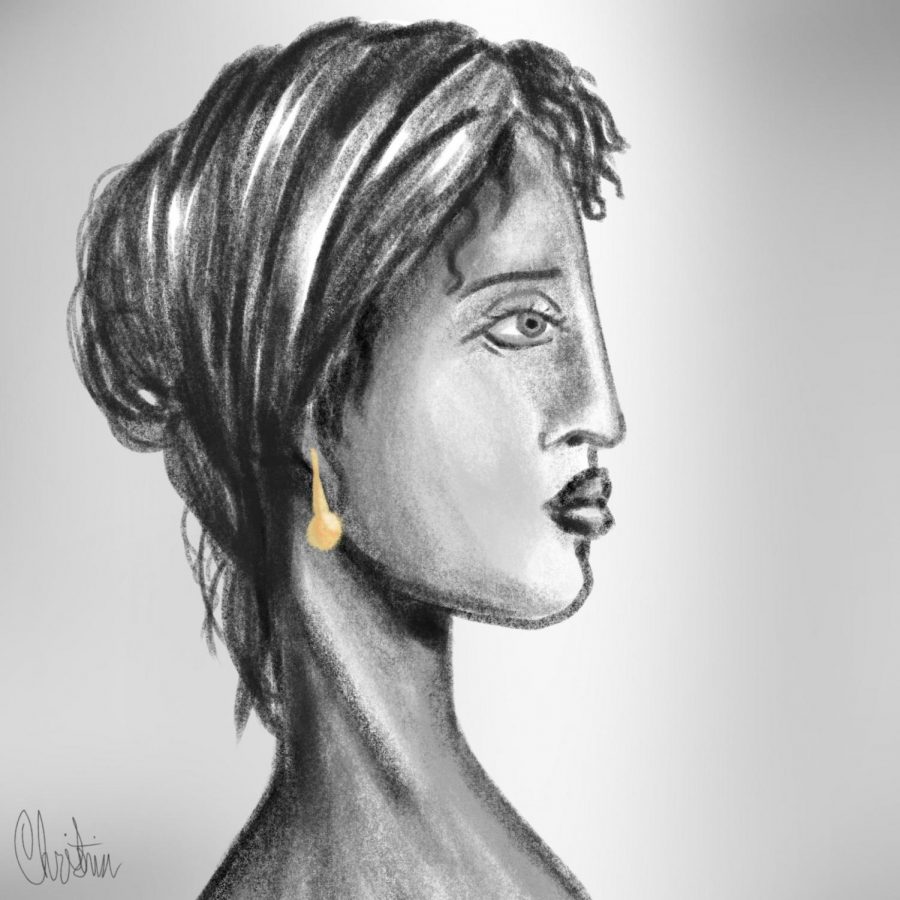Misconceptions in History: Cleopatra
Common misconceptions about Cleopatra. Who is she really?
What Cleopatra might’ve looked like, referenced from a painted portrait of Cleopatra from Roman Herculaneum dated to the First Century AD.
April 8, 2021
Despite her name being so widely known, there are many misconceptions about Cleopatra. People have little to no knowledge about who Cleopatra truly was. Out of the multiple misconceptions, which ones are true? Let’s take a deeper dive.
The first misconception is Cleopatra’s nationality. While Cleopatra was the queen of Egypt, she was not actually Egyptian. Her ancestry dates back to the Macedonian Greeks and Ptolemy I Soter, one of Alexander the Great’s generals who took over Egypt after Alexander’s death in 323 B.C. Ptolemy started his dynasty of Greek speakers in Egypt lasting almost three centuries. Cleopatra’s name is also Greek, deriving from the Greek word “Kleopátra” (Κλεοπάτρα) meaning “glory of her father”.
The second misconception is Cleopatra’s boundless beauty. Was Cleopatra an actual beauty as people say? Known for her charming persona by many, but is charm the same as beauty? Charm is the “power or quality of giving delight or arousing admiration” defined by the Oxford dictionary. Beauty is more about the outside or physical appearance. Therefore saying someone is charming is different than saying they are beautiful. According to some modern historians, Cleopatra was not an exceptional beauty. She wasn’t one who was incomparable nor one to strike those who glanced upon her. What made her a famous temptress was her charm. She had a sweet voice, an air of persuasiveness, and a stimulating presence. Plutarch, in his Life of Antony, emphasized “converse with her had an irresistible charm, and her presence… had something stimulating about it. There was sweetness also in the tones of her voice.” This follows the idea that charm and beauty are two different things despite being so similar. Artifacts later discovered give us some clues of what Cleopatra actually looked like. “An aquiline nose is the most prominent feature of the profiles of Cleopatra on contemporary coins (issued by Cleopatra or in her name) that are widely held to give the best representation of her appearance. On some of the coins, her nose is less hooked, her cheeks are full, and her chin is small, as on the marble busts,” said Jeff Wallenfeldt, manager of Geography and History for Britannica. Upon further analysis, it implies that Cleopatra believed herself to be a goddess, or the embodiment of the Greek goddess of beauty, Aphrodite. She knew how to make an entrance, which added to her irresistible charm. Though she wasn’t the celestial beauty people believe her to be, she knew her attributes and how to take advantage of them.
Now that I’ve addressed some of the misconceptions, let’s talk about things uncommonly heard. The first being that she was the product of incest. Her parents were quite possibly closely related and some believe they were siblings. To preserve the purity of their bloodline, the family married within themselves so several of Cleopatra’s family members married their sibling or cousin. Cleopatra also went on to marry two of her brothers.
The second is the fact that Cleopatra was Julius Caesar’s mistress. It was widely known that Caesar openly showed their relationship and Cleopatra took their child to the city of Rome. She was living in Rome when her ally and lover, Caesar was assassinated by being stabbed to death in the Roman Senate in 44 B.C. forcing Cleopatra to flee the city.
Something widely known is power struggles for a throne resulting in a massive bloodbath, even between siblings. Cleopatra’s family was no different, and she had a hand in three of her siblings’ deaths. Consequently, her brother/husband was the first to fall after teaming up with his half-sister, Arsinoe. He chased Cleopatra out of Egypt which led her to form an alliance with Caesar. Inevitably unable to win the war, her brother drowned himself. Moreover, she was behind the execution of her sister, Arsinoe, who she saw as a threat in 41 B.C. After the war, she remarried her younger brother and is believed to have murdered him to make her son with Caesar, Caesarion, a co-ruler.
Like I mentioned earlier, Cleopatra believed herself to be Aphrodite or at least the embodiment. This follows along with her last and final husband, Mark Antony, who was said to believe himself the embodiment of the Greek god of grape harvest and wine, Dionysus. They first began their widely known scandal in 41 B.C. Their affair gave many political benefits. Cleopatra was able to give Antony access to Egypt’s resources and riches while Antony protected her crown and Egypt’s freedom. They later got married causing even more uproar. Antony’s rival, Octavian, used propaganda and said Antony was a traitor under the influence of a seductress. This sparked the Roman Senate to declare war against Cleopatra. The two were unable to fight against Octavian’s navy and were forced to flee to Egypt. After fleeing Rome, Cleopatra and Antony took their lives in 30 B.C. after Octavian’s forces pursued them to Alexandria. The cause of Antony’s death was him stabbing himself in the stomach. Cleopatra’s death, however, is unknown. According to historians, Cleopatra concealed a deadly poison in one of her hair combs. It is said that she used some form of potent toxin, snake’s venom, or other. The ancient Plutarch said, “What really took place is known to no one.”
The last thing I am going to address is Cleopatra’s legacy. Queen Cleopatra VII is known as a charming seductress. She was an intelligent ruler and studied a plethora of subjects. In their article, “Cleopatra’s legacy in art: famous pharaoh and femme fatale” Hermenia Powers wrote “Just like any Pharaoh of Egypt, her role demanded that she be a talented strategist and administrator. Not only that, history recalls that she was a polymath and academically accomplished, studying a plethora of subjects, including medicine.”
In conclusion, Cleopatra was someone who knew how to use her attributes and intelligence to her advantage. Her relationships with Caesar and Mark Antony gave her many political benefits. She was a smart leader. Maybe that is why she is still widely known to this day.
Sources:
https://www.behindthename.com/name/cleopatra
https://artuk.org/discover/stories/cleopatras-legacy-in-art-famous-pharaoh-and-femme-fatale#
https://www.britannica.com/story/what-did-cleopatra-look-like
https://www.history.com/news/10-little-known-facts-about-cleopatra
https://www.britannica.com/biography/Cleopatra-queen-of-Egypt
https://www.history.com/.amp/topics/ancient-history/cleopatra
https://brightside.me/wonder-people/20-facts-about-cleopatra-that-you-wont-hear-in-school-798855/
https://www.discovermagazine.com/planet-earth/what-did-cleopatra-really-look-like






